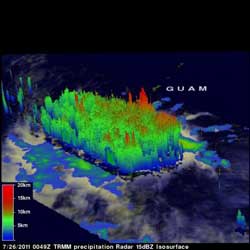Tropical Depression 11W moving past Yap and Guam

The Tropical Rainfall Measuring Mission (TRMM) satellite data was used to create a 3-D image of Tropical Depression 11W's rainfall and cloud heights as it passed overhead on July 26. TD11W had towering convective storms near their centers of circulation that extended to heights above 15km (~9.3 miles) with heavy rainfall, falling at 2 inches (50 mm) per hour. Credit: NASA/SSAI, Hal Pierce<br>
Yap and Guam are both experiencing the tail end of gusty winds and rains as Tropical Depression 11W moves between the two islands in the western North Pacific today.
At 0900 UTC (5 a.m. EDT) on July 27, Tropical Depression 11W's (TD11W) maximum sustained winds were still near 30 knots (34 mph). It was located about 290 nautical miles southwest of Andersen Air Force Base, Guam near 10.7 North and 140.5 East. It was moving to the northwest near 12 knots (14 mph).
When NASA's Aqua satellite passed over TD11W on July 26 at 16:05 UTC (12:05 p.m. EDT) the center of circulation appeared much more rounded than it had in the previous days, indicating that the storm was getting better organized. The Atmospheric Infrared Sounder (AIRS) instrument captured the infrared image that showed powerful, high thunderstorms with cold cloud tops surrounded the center of TD11W's circulation, although the center is partially exposed to outside winds. There were also a number of bands of thunderstorms around the center. TD11W is kicking up waves of 12 feet high, and generating rough surf at Yap and Guam.
TD11W is moving around the western edge of a low to mid-level ridge of high pressure, and will continue in a northwestward direction for the next day or two. After that, the ridge is expected to weaken and the storm track will head in a more northeasterly direction.
Media Contact
More Information:
http://www.nasa.govAll latest news from the category: Earth Sciences
Earth Sciences (also referred to as Geosciences), which deals with basic issues surrounding our planet, plays a vital role in the area of energy and raw materials supply.
Earth Sciences comprises subjects such as geology, geography, geological informatics, paleontology, mineralogy, petrography, crystallography, geophysics, geodesy, glaciology, cartography, photogrammetry, meteorology and seismology, early-warning systems, earthquake research and polar research.
Newest articles

Sea slugs inspire highly stretchable biomedical sensor
USC Viterbi School of Engineering researcher Hangbo Zhao presents findings on highly stretchable and customizable microneedles for application in fields including neuroscience, tissue engineering, and wearable bioelectronics. The revolution in…

Twisting and binding matter waves with photons in a cavity
Precisely measuring the energy states of individual atoms has been a historical challenge for physicists due to atomic recoil. When an atom interacts with a photon, the atom “recoils” in…

Nanotubes, nanoparticles, and antibodies detect tiny amounts of fentanyl
New sensor is six orders of magnitude more sensitive than the next best thing. A research team at Pitt led by Alexander Star, a chemistry professor in the Kenneth P. Dietrich…





















